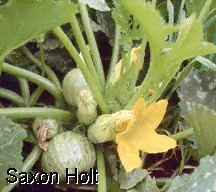
| |
 |
![]()
 Mother Earth News, Sep/Oct 1987
Mother Earth News, Sep/Oct 1987
The Easiest Seed-Saving Crops
By Nancy Bubel
This large group embraces fruits as diverse as cucumbers, gourds, melons, pumpkins and zucchini. In all cases, blossoms are pollinated by insects, male and female flowers are separate, and crossing between varieties that accept each other's pollen occurs at distances up to at least 100 feet. (Indeed, commercial seed breeders keep related cucurbit crops 1/4 mile apart.) Since plants can cross only within a species, and cucumbers, watermelons, cantaloupes and pumpkins all belong to separate species, they can't cross with each other. Zucchinis and gourds are members of the same species, so they can produce some crazy crosses. Buttercup and banana squash will cross as well.
How can you keep it all straight? Follow this rule. In any one year, you can save seed - without bothering to separate the varieties - of cucumbers, cantaloupes, watermelon and any one member of each of the following:
- Cucurbita pepo:
- Members of this group have deeply grooved, ridged and prickly five-sided stems and include striped and warted gourds, Lady Godiva, Small Sugar and Connecticut Field pumpkins, and acorn, cocozelle, crookneck (summer), scallop, spaghetti and zucchini squash.
- Cucurbita maxima:
- Stems are round, hairy and somewhat soft. Members include Hubbard, turban, delicious, banana, marblehead and buttercup squash.
- Cucurbita moschata:
- The smoother five-sided stem widens at the base. Moschata members include golden cushaw and butternut, cheese and melon squash.
- Cucurbita mixta:
- The vines resemble those of C. moschata. Members include cushaws (except for golden cushaw), Tennessee sweet potato, Japanese pie and mixta gold. All seed cucurbits should be allowed to remain on the vine until the skin hardens, so the seeds can mature. Most seeds will be more viable if allowed to after-ripen in the fruit for 20 days past maturity. Rinse off the pulp and dry the seed on screens before storing.
If your garden is close to others where cucurbits grow, if you want to keep seed of several related varieties in the same year, or if other people will be depending on the purity of your seeds (for instance, if you're part of a seed savers' exchange), you should hand-pollinate your cucurbits. First, examine the flowers of a healthy, productive plant. A male flower has a slender stem, while the base of a female flower has a small swelling of undeveloped fruit. Work only with blossoms that have not yet opened. (Once the blossom has opened, you should assume that it's already been pollinated.)
Tape several perky but still closed male and female flowers shut, or fasten small bags over them. Then when the flowers have opened (probably the following morning), uncover one male flower and several female flowers from different plants. Pick off the male's petals, then gently but firmly touch its pollen-laden anthers to the stigmas of the females. Next, recover the pollinated females with envelopes or small bags, and carefully wire them shut. Leave the protecting covers on for several days. Then remove them so the fruits won't rot or develop abnormally. Don't forget to label the pollinated flowers!
The Arc Institute
Cucumbers like lots of water. Planting in hills with a depression in the center makes it easier to water them effectively. Plant 1/2” deep, 2 or 3 plants per hill, 5 feet apart. For seed production, allow the cucumber to go yellow and orange. Cucumbers are not highly nutritious, but provide Vitamin A. Cucumbers are very cold sensitive, and need warm weather and soil.
Summer squash matures quickly and is prolific. Picking summer squash regularly will encourage more production of squash. Leave any squash grown for seed to become large and fully mature. Winter squash matures later and should be left on the wine to mature and harden. Winter squash is a heavy feeder, and does well when planted in the compost pile. Pick winter squash before the first frosts and store in a cool cellar. Plant 1/2” deep, 1’ or more apart in rows 4-5’ apart. Plant when the soil is 75 degrees or warmer.